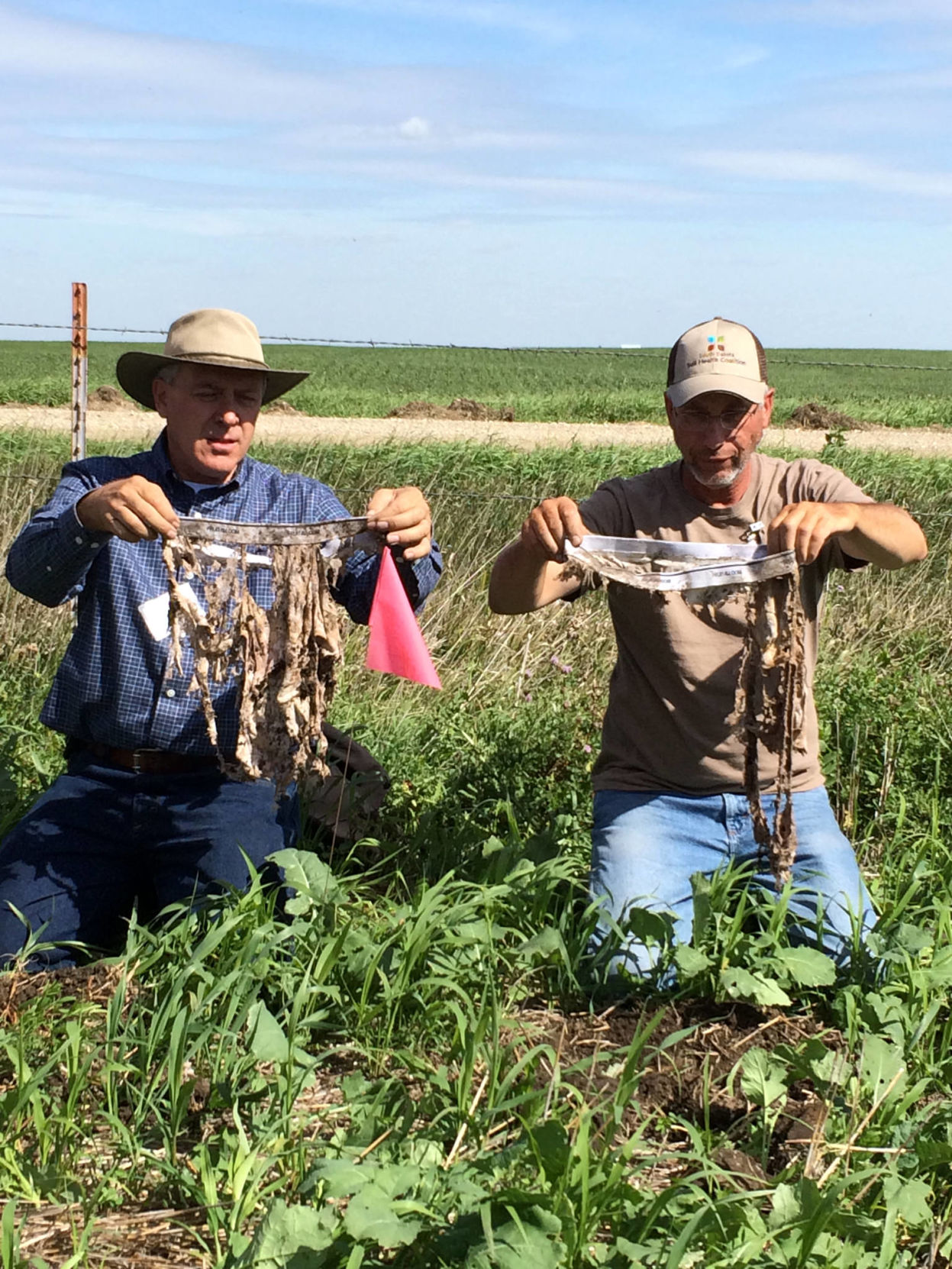South Dakota farmers are planting something new to test soil quality—their tighty whities. They start with a few pairs of clean 100 percent cotton briefs, bury them a couple inches in the soil and dig them up about six weeks later.
Poor quality soil will yield almost fully-intact briefs, but biologically active, high quality soil will leave the briefs in tattered remnants, with only the elastic band remaining.
While the sight of someone out in a field burying underwear may raise some eyebrows, it’s an effective way to hit home one key point: healthy soil is active soil.
Dennis Hoyle of Roscoe, South Dakota, buried some briefs when he hosted the first South Dakota Soil Health School held by the South Dakota Soil Health Coalition. When Hoyle buried a brief in a reduced-tillage soybean field, it had much less material remaining than the brief buried in the field of conventional tilled corn.
“We need to keep the roots and residue on the soil so that we have more activity to eat up the cotton (carbon) in the underwear,” explained Hoyle. “Tilled land does not have enough of the biology to “eat” the tighty whities,” he said. “When you are tilling the land, it’s like you are creating a tornado in the soil and removing much of what’s hungry for carbon.”
The annual Soil Health School features classroom style presentations from producers and technical experts from across the state and region, as well as hands-on experiences in the field. It is designed for agricultural producers as well as well as anyone with an interest in learning how to manage soils for resiliency and profit and is typically held each September. This year the school is slated for September 5 to 7 at the Kurt and Kathy Stiefvater farm near Salem, South Dakota.
How to run this brief test
The “bury your briefs” test is simple and easy to perform. Whether done in a field or garden, it’s fun to do a comparison and choose areas where the soil has been managed differently, such as a long-term no-till area compared to a conventional tillage area.
To run the test, take a few pairs of men’s cotton underwear and bury them horizontally in the ground for six to eight weeks then dig them up. Compare the weight of new briefs to the ones that were buried. The weights and level of decomposition should provide a telling picture of what’s going on with the soil.
“This experiment is a fun way to look at soil quality,” explained Eric Barsness, Natural Resources Conservation Service agronomist, Brookings, South Dakota. “With proper management, the ground beneath your crops should teem with millions of tiny lifeforms—bacteria, fungi, protozoa, nematodes, arthropods, earthworms—all eating and decomposing organic material, such as the carbon in the briefs.”
If the briefs are intact, the soil biology needs improvement. Barsness explained the best way to improve the soil biology is to follow the basic principles of soil health.
“Make sure to keep the soil covered with residue, which provides a consistent temperature and moisture level for microbes to thrive,” he said. “And limit tillage and any soil disturbance.”
Barsness said another key principle of soil health is keeping a living root in the soil. “Keeping those roots will aid water infiltration and air movement,” he explained.
Also, integrate livestock in the fields, added Barsness.
“Grazing livestock will break down crop residues and increase soil microbial activities.”
Farm operator Jon Rohrbach said the test really opened his eyes and caused him to change the way he managed his soil.
“I thought I was doing everything right before I went to the soil health school, but it taught me I was doing some things that were counterproductive,” said Rohrbach, whose farm is located northeast of Roscoe.
Rohrbach has practiced no-till for the past twenty years.
“But once in a while, I tilled to get the residue down, and that’s where I was being counterproductive for my goal of having healthy soil.” He shifted his practices and has done absolutely no tillage in the past 3 years.
Producer Brian Hoffman, of Leola, also attended the Soil Health School in 2017. Hoffman grows corn, beans and oats and has cattle. The briefs that he dug up were almost completely disintegrated from soil activity—with only the elastic band remaining.
“I learned from that experience that it’s much better not to work the soil,” he said. “Tilling just breaks down the structure, it does not add anything.”
Seeing the results of the test “reinforced for me that no-till really does work,” he added. “Add in cover crops and cattle on that land, and all of that works together to improve that soil.”
Don Nickelson, farm owner near Frederick, South Dakota, also attended soil health school and saw the comparison of briefs. “It was amazing to see how the no-till soil was able to dissolve the underwear compared to ground that had been tilled,” he said. “It really got me thinking at different ways to improve my soil.”
Burying your briefs year after year is a good way to measure the progress of your soil health over time.
For more information on the principles of soil health and resources in your area, visit your local Natural Resources Conservation Service office or visit www.sdsoilhealthcoalition.org. You can also contact the South Dakota Soil Health Coalition at 605-280-4190 or [email protected].



